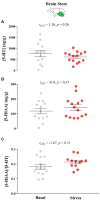Behavioral and neurophysiological effects of buspirone in healthy and depression-like state juvenile salmon
- PMID: 38410095
- PMCID: PMC10894974
- DOI: 10.3389/fnbeh.2024.1285413
Behavioral and neurophysiological effects of buspirone in healthy and depression-like state juvenile salmon
Abstract
A proportion of farmed salmon in seawater show a behaviorally inhibited, growth stunted profile known as a depression-like state (DLS). These DLS fish are characterized by chronically elevated serotonergic signaling and blood plasma cortisol levels and the inability to react further to acute stress, which is suggestive of chronic stress. In this study, we characterize the neuroendocrine profile of growth stunted freshwater parr and confirm that they show a DLS-like neuroendocrine profile with a blunted cortisol response and no serotonergic increase in response to acute stress. Furthermore, we attempted to reverse this DLS-like profile through pharmacological manipulation of the serotonin (5-HT) system with buspirone, an anxiolytic medication that acts as a serotonin receptor agonist (i.e., decreases serotonergic signaling). We found that while buspirone decreases anxiolytic-type behavior in healthy fish, no quantifiable behavioral change was found in DLS-like fish. However, there was a physiological effect of diminished basal serotonergic signaling. This suggests that at the physiological level, buspirone appears to reverse the neuroendocrine DLS profile. With a deeper understanding of what causes DLS profiles and growth stunting in juvenile fish, steps can be taken in terms of husbandry to prevent repeated stressors and the formation of the DLS profile, potentially reducing losses in aquaculture due to chronic stress.
Keywords: behavioral inhibition; chronic stress; cortisol; depression models; serotonergic activity.
Copyright © 2024 Shapouri, Sharifi, Folkedal, Fraser and Vindas.
Conflict of interest statement
The authors declare that the research was conducted in the absence of any commercial or financial relationships that could be construed as a potential conflict of interest.
Figures








References
LinkOut - more resources
Full Text Sources

